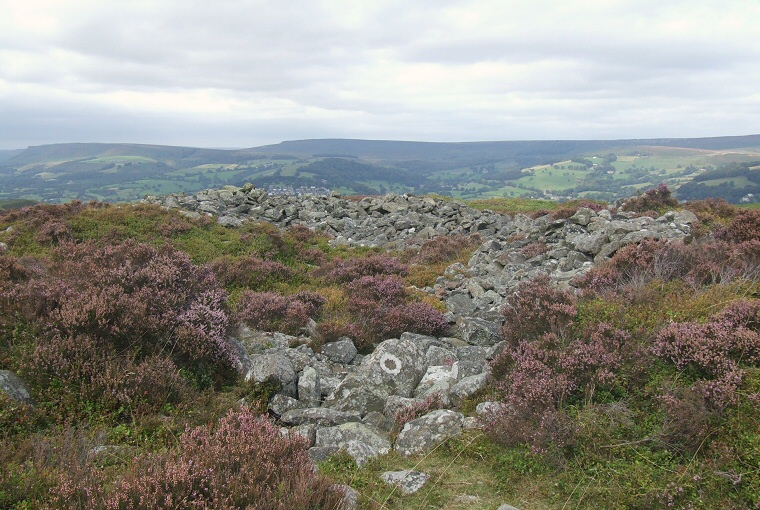
Antiquarian records suggest that it may have originally been a large oval or round cairn. William Wood writing about the monuments on Eyam Moor in the mid 19th century says - 'there was, until some years back, one of the most interesting British barrows in the Peak of Derbyshire. It covered an area of ground from twenty-five to thirty yards (23-27 m) in diameter. It was in the form of a cone, ten or twelve yards (9-11 m) high, when perfect ; and was composed wholly of small stones. On opening this cairn, or barrow, many years ago, an unbaked urn was found, containing ashes, bones, an arrow-head of flint, and a little charcoal with which the body had been burned. ... nothing, however, has been found recently except the urn, some arrow-heads, axes, and other implements of war.' The finds suggest an early to middle Bronze Age date (at least for the finds if not the cairn) and if Wood was correct then it would have been a truly massive mound, although the height he gives of c10 metres would seem to be rather unlikely.
Other sources suggest the monument may have been two or three smaller cairns that were either enlarged and linked together in prehistory (see the triple cairn at Raven Tor) or by more recent disturbance. Another possibility is that the mound may have its origins as a Neolithic long cairn which would then pre-date the circle of Wet Withens itself, with the the burial of the urn being a later re-use of the site. It is more probable however that the cairn was a later addition or adjunct to the pre-existing stone circle.
Whatever it was, unrecorded excavations, stone robbing and possible damage caused by nearby quarrying means that what remains at the site today is a tumbled mess of stones measuring about 28 metres by 18 metres and up to about a metre in height aligned roughly southwest to northeast. Interestingly, in recent years a possible single cup marked rock was discovered towards the centre of the cairn.
The close proximity of the cairn to Wet Withens means it is mentioned by several of the same antiquarian sources as the circle, albeit sometimes only briefly. Some sources quote an interesting account by John Wilson later recorded by Thomas Bateman which describes the finding of an urn within a cairn on Eyam Moor in June 1759 by some workmen taking stone for nearby road making. John Barnatt (1996) from the Peak District Archaeology Service however believes that the account relates to a different monument but I've included it here for completeness. -
'An urn was found in a large heap of stones, upon Eyam Moor (Derbyshire), called the "Round Hillock" ... of red earth, and so large it would contain about two pecks of corn. It was about ten inches and a half (27 cm) over the top, more than eighteen inches (46 cm) deep, and ran tapering to a bottom of about two inches and a half (6 cm), and a hollow broad ledge hanging over the top. In it was found burnt bones, and a small round earthen vessel, about five inches (13 cm) diameter and two inches (5 cm) high, of a common brown clay colour, which had nine round holes in the sides; and in it were several beads, of about two inches (5 cm) long and half an inch (1.3 cm) diameter in the middle: they were of a brown, or rather amber colour, and notwithstanding their antiquity, retained a strong aromatic smell.'
Site Visits / Photographs:
September 2007, November 2010.
References:
Andrew, W. 1907. Prehistoric Stone Circles of Derbyshire. In Cox, C. (ed.) Memorials of Old Derbyshire. 70-88.
Barnatt, J. 1978. Stone Circles of the Peak. London: Turnstone Books.
Barnatt, J. 1986. Bronze Age Remains on the East Moors of the Peak District. D.A.J., Vol 106, 18-100.
Barnatt, J. and Collis, J. 1996. Barrows in the Peak District. Recent Research. J. R. Collis Publications.
Barnatt, J. and Reeder, P. 1982. Prehistoric Rock Art in the Peak District. D.A.J., Vol 102, 33-44.
Barnatt, J. and Robinson, F. 2003. Prehistoric Rock-Art...new discoveries... Peak District. D.A.J., Vol 123, 1-28.
Bateman, T. 1861. Ten years diggings in Celtic and Saxon grave hills in the counties of Derby.... London: Smith.
Burl, A. 1995. A Guide to the Stone Circles of Britain, Ireland and Brittany. London: Yale University Press.
Edmunds, M. and Seaborne, T. 2001. Prehistory in the Peak. Stroud: Tempus.
Morgan, V. and Morgan, P. 2001. Rock around the Peak. Wilmslow: Sigma Leisure.
Pennington, R. 1875. Tumuli and Stone Circles near Castleton. Journal ... Royal Anthropological Inst. 377-384
Thompson, D. 1963. Arbor Low and three other Prehistoric sites in Derbyshire. London: HMSO.
Wood, W. 1848. The History and Antiquities of Eyam. Second Edition. London: Longman.
Historic England Research Records Hob Uid: 311795.
Scheduled Monument: 31233.
National Monuments Record Number: SK 27 NW 2.
HER Number: 5442.
County Number DR 2.